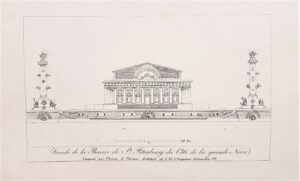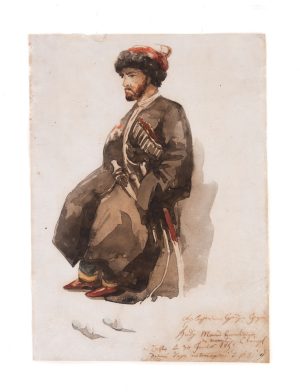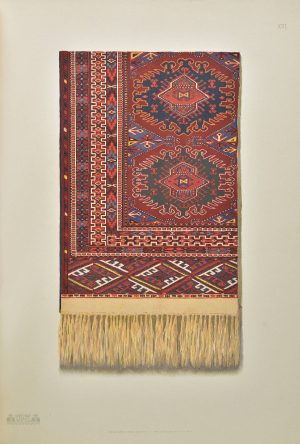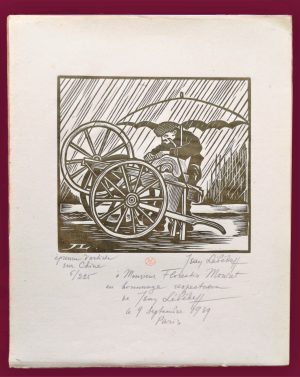Our Notes & References
Charming Old Believers’ luxury production with vignettes, ornaments, palms and 14 striking full-page miniatures in gold and bright colours, signed by an artist found in the Tsar’s collections.
Complete, with contemporary bourgeois provenance: inscribed to “Ivan Pavlovich Vagin on the day of your angel this 14th September 1891 in remembrance of the love of Christ, respecting and loving you Ger.[asim Denisovich] Malyshev”, a wealthy merchant based in the town of Gorodets, descending from a peasant family in the Nizhny Novgorod region. The book was later in the ownership of Klavdiia Nover, whose inscription reads: “The almanac was left to me after my dear father, who passed away on 28 February (old style) / 13 March (new style) 1942”.
Each of these owners carefully though extensively used the almanac on a regular basis leaving frequent marginal notes to document memorable dates in their lives, and particularly deaths of their friends and relatives: the margins bear around two dozen names, including those of the prominent Old Believers Zinoviia Bugrova (?-1916) and her brother Nikolai Aleksandrovich Bugrov (1837-1911), a major Nizhny Novgorod merchant and a distinguished philanthropist. The notes end in 1970.
From its very first page, the manuscript’s energetic imagery deviates from the canon of the Russian Orthodox Church productions: the striking combination of the icon-style linear representations of saints with flowerful and bright patterns, especially common in popular lubok pictures, echoes with later works by the avant-garde artist Natalia Goncharova, who was indeed inspired by Old Believers’ illuminations and folk art. All 14 miniatures are nicely detailed and compositionally advanced, most of the time with a lovely background of fantastical, fancily patterned architecture. Similarly impressive are the thirteen decorative divisional pages with exquisite floral and ornamental frames accentuated in gilt, as well as the head- and tailpieces, vignettes, marginal hands and initials.
The artist’s bold style appears to be pretty original: we could not find any other manuscripts or printed works to have similar illustrations or to be a prototype of the present work, signed by Fedor Petrovich Miatelkov.
Little is known about Miatelkov. The Tretyakov Gallery describes him as “peasant scribe and artist”, and the Moscow museum holds the only other work we could find by him: a manuscript Gospel for Tsar Alexander III from the Gatchina Palace. The work initially was intended for Alexander II, but after the tsar’s tragic death it was “dedicated to His Imperial Majesty Alexander Alexandrovich”. Vengerov suggests that F. P. Miatelkov worked at the Pastorskii Sobesednik [Pastors’ Companion], a spiritual journal, published weekly in 1884-1910 in Voronezh and Moscow. However wecould not find Miatelkov among the journal’s authors, nor any further information about him.
Written and illuminated between 13 April and 23 July 1887, the almanac opens with “The arrangement of the church singing and the all-year assembly, from the month of September to the month of August, according to the statutes of the holy Jerusalem Lavra of our Venerable and God-bearing father Sabbas the Sanctified”, a Cappadocian Greek monk who established a set of guidelines defining the structure and order of Orthodox divine services. These compact indications for each day include exact times of the sunrise and sunset, names of the saints and the canonised to worship, important religious events, instructions on what icons to venerate, and even some historic dates, such as Napoleon’s entry into Moscow on September 2.
The daily index is followed by a table for determining the dates of Easter celebration and other movable feasts for the years from 1887 to 1940, which is the last year of the 14th Indiction, or a period of time of 532 years of the great Easter circle. The next part is “Paskhalia” with a short guide on the days of fasting and various holidays, then the schedule of Lunar phases for the cycle of 19 years, tables for determining Solar cycles, and thirty-seven large drawings of palms of a left hand to facilitate the calculation of important holidays and lunar and solar cycles with a relevant instruction. Such a method of calculation, called “Ruka Damaskina” [“Hand of John of Damascus”], was present only in religious books published before the reforms of Patriarch Nikon and the schism of the Russian Church in 1653. The Old Believers who rejected Nikon’s modernisations preserved this tradition in their manuscripts and publications.
Provenance
Gerasim Denisovich Malyshev (possibly the first owner; stamp on lower endpaper; given in 1891 to:); Ivan Pavlovich Vagin (gift inscription on lower endpaper); Klavdiia Nover (1940s inscription on upper endpaper).
Bibliography
Chiniakova G. P., Ignasheva A. A. “Rukopisnoe Evangelie Tetr kontsa XIX veka gosudaria imperatora Aleksandra III iz gatchinskogo dvortsa v sobranii Tretiakovskoi galerei” // Iskusstvo khristianskogo mira. Sb. statei. Vyp. 7. — M.: Izd-vo PSTBI, 2003, pp. 301–304; Vengerov Semen Afanasievich, “Miatelkov P. V.”, Bolshaia biograficheskaia entsiklopediia, 2009.
Physical Description
Small octavo (13.7 x 10.2 cm). Manuscript in black and red. Frontispiece, 157 ll. in red and black ink, incl. 13 full-page miniatures in various colours with gold, gilt and coloured ornaments, marginal hands and many initials, paginated in Slavonic numerals; apparently no visible watermarks.
Binding
Contemporary red velvet, all edges gilt, green endpapers.
Condition
Binding faded, stained and rubbed, crudely repaired with later cloth spine, paper corners and patterned green endpapers, block detached at upper hinge, one leave loose and a bit frayed; light foxing throughout, soiling in lower corners, occasional light staining, marginal notes by different owners in black, brown and purple inks, pencil and pen, many dated.

![Image for [OLD BELIEVERS] - MIATELKOV, F.P. Sviattsy. Manuscript dated 1887. Complete #2](https://www.pyrarebooks.com/wp-content/uploads/2024/01/2543_1.jpg)
![Image for [OLD BELIEVERS] - MIATELKOV, F.P. Sviattsy. Manuscript dated 1887. Complete #3](https://www.pyrarebooks.com/wp-content/uploads/2024/01/2543_2.jpg)
![Image for [OLD BELIEVERS] - MIATELKOV, F.P. Sviattsy. Manuscript dated 1887. Complete #4](https://www.pyrarebooks.com/wp-content/uploads/2024/01/2543_3.jpg)
![Image for [OLD BELIEVERS] - MIATELKOV, F.P. Sviattsy. Manuscript dated 1887. Complete #5](https://www.pyrarebooks.com/wp-content/uploads/2024/01/2543_4.jpg)
![Image for [OLD BELIEVERS] - MIATELKOV, F.P. Sviattsy. Manuscript dated 1887. Complete #6](https://www.pyrarebooks.com/wp-content/uploads/2024/01/2543_5-scaled.jpg)
![Image for [OLD BELIEVERS] - MIATELKOV, F.P. Sviattsy. Manuscript dated 1887. Complete #7](https://www.pyrarebooks.com/wp-content/uploads/2024/01/2543_6.jpg)
![Image for [OLD BELIEVERS] - MIATELKOV, F.P. Sviattsy. Manuscript dated 1887. Complete #8](https://www.pyrarebooks.com/wp-content/uploads/2024/01/2543_7.jpg)
![Image for [OLD BELIEVERS] - MIATELKOV, F.P. Sviattsy. Manuscript dated 1887. Complete #9](https://www.pyrarebooks.com/wp-content/uploads/2024/01/2543_8.jpg)
![Image for [OLD BELIEVERS] - MIATELKOV, F.P. Sviattsy. Manuscript dated 1887. Complete #10](https://www.pyrarebooks.com/wp-content/uploads/2024/01/2543_9-scaled.jpg)
![Image for [OLD BELIEVERS] - MIATELKOV, F.P. Sviattsy. Manuscript dated 1887. Complete #12](https://www.pyrarebooks.com/wp-content/uploads/2024/01/2543_11-scaled.jpg)
![Image for [OLD BELIEVERS] - MIATELKOV, F.P. Sviattsy. Manuscript dated 1887. Complete #13](https://www.pyrarebooks.com/wp-content/uploads/2024/01/2543_12-scaled.jpg)
![Image for [OLD BELIEVERS] - MIATELKOV, F.P. Sviattsy. Manuscript dated 1887. Complete #14](https://www.pyrarebooks.com/wp-content/uploads/2024/01/2543_13-scaled.jpg)
![Image for [OLD BELIEVERS] - MIATELKOV, F.P. Sviattsy. Manuscript dated 1887. Complete #16](https://www.pyrarebooks.com/wp-content/uploads/2024/01/2543_15-scaled.jpg)
![Image for [OLD BELIEVERS] - MIATELKOV, F.P. Sviattsy. Manuscript dated 1887. Complete #2](https://www.pyrarebooks.com/wp-content/uploads/2024/01/2543_1-300x392.jpg)
![Image for [OLD BELIEVERS] - MIATELKOV, F.P. Sviattsy. Manuscript dated 1887. Complete #3](https://www.pyrarebooks.com/wp-content/uploads/2024/01/2543_2-300x300.jpg)
![Image for [OLD BELIEVERS] - MIATELKOV, F.P. Sviattsy. Manuscript dated 1887. Complete #4](https://www.pyrarebooks.com/wp-content/uploads/2024/01/2543_3-300x300.jpg)
![Image for [OLD BELIEVERS] - MIATELKOV, F.P. Sviattsy. Manuscript dated 1887. Complete #5](https://www.pyrarebooks.com/wp-content/uploads/2024/01/2543_4-300x238.jpg)
![Image for [OLD BELIEVERS] - MIATELKOV, F.P. Sviattsy. Manuscript dated 1887. Complete #6](https://www.pyrarebooks.com/wp-content/uploads/2024/01/2543_5-300x400.jpg)
![Image for [OLD BELIEVERS] - MIATELKOV, F.P. Sviattsy. Manuscript dated 1887. Complete #7](https://www.pyrarebooks.com/wp-content/uploads/2024/01/2543_6-300x367.jpg)
![Image for [OLD BELIEVERS] - MIATELKOV, F.P. Sviattsy. Manuscript dated 1887. Complete #8](https://www.pyrarebooks.com/wp-content/uploads/2024/01/2543_7-300x452.jpg)
![Image for [OLD BELIEVERS] - MIATELKOV, F.P. Sviattsy. Manuscript dated 1887. Complete #9](https://www.pyrarebooks.com/wp-content/uploads/2024/01/2543_8-300x395.jpg)
![Image for [OLD BELIEVERS] - MIATELKOV, F.P. Sviattsy. Manuscript dated 1887. Complete #10](https://www.pyrarebooks.com/wp-content/uploads/2024/01/2543_9-300x399.jpg)
![Image for [OLD BELIEVERS] - MIATELKOV, F.P. Sviattsy. Manuscript dated 1887. Complete #12](https://www.pyrarebooks.com/wp-content/uploads/2024/01/2543_11-300x400.jpg)
![Image for [OLD BELIEVERS] - MIATELKOV, F.P. Sviattsy. Manuscript dated 1887. Complete #13](https://www.pyrarebooks.com/wp-content/uploads/2024/01/2543_12-300x363.jpg)
![Image for [OLD BELIEVERS] - MIATELKOV, F.P. Sviattsy. Manuscript dated 1887. Complete #14](https://www.pyrarebooks.com/wp-content/uploads/2024/01/2543_13-300x343.jpg)
![Image for [OLD BELIEVERS] - MIATELKOV, F.P. Sviattsy. Manuscript dated 1887. Complete #16](https://www.pyrarebooks.com/wp-content/uploads/2024/01/2543_15-300x369.jpg)



